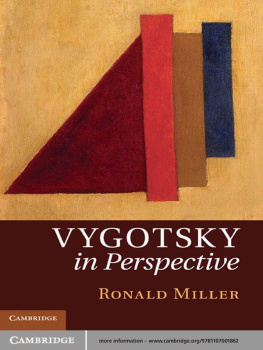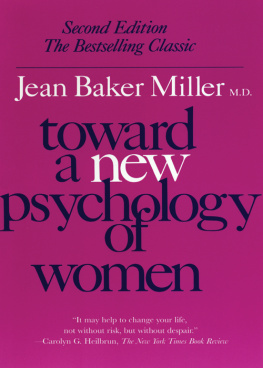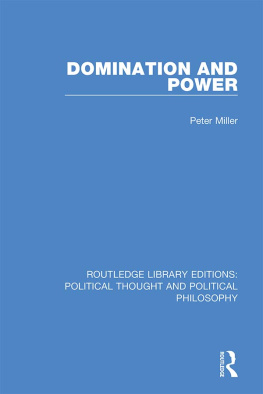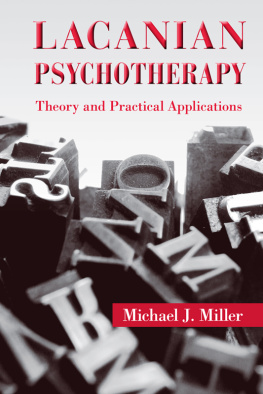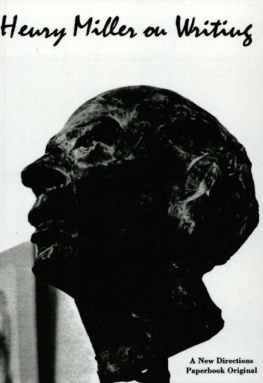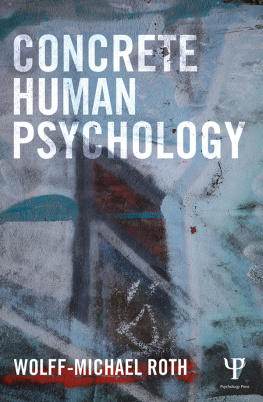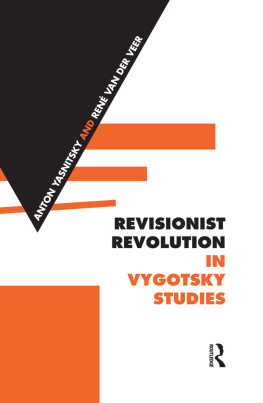This book was not written according to a preconceived plan. Its shape as a book was slow in the making; too slow some may say and for others, not slow enough. The written word, or written speech to use Vygotsky's expression, especially in the form of a book, is one of the strange things that humans do like painting images on flat surfaces, carving and moulding shapes, composing melodies and other activities that seem unrelated to our survival in the way that making fire and tools increases the range of our adaptive abilities. Perhaps these are human ways of releasing the song within so that we can go to our graves less desperate for being heard. The primary motive force hidden behind this text is an abiding fascination with the enigmatic phenomenon of human consciousness, that core of our being that makes us thinkingunderstanding creatures with an insatiable and deep-seated need to find and make meaning in our lives. It is hardly surprising, then, that Vygotsky's cultural-historical psychology would loom large in my teaching and research activities.
In retrospect, this book was conceived some twenty-five years ago in embryonic form as an inaugural lecture entitled Reflections of mind and culture. One of the themes of that lecture was that Piaget's and Vygotsky's theories are not alternatives requiring a forced choice between them but are best understood as complementary and mutually supportive approaches to understanding the origins and development of thinking. With the subsequent publication of Vygotsky's Collected Works , this view can be better substantiated and it constitutes one of the sub-themes of this book. Although this book is primarily about Vygotsky, discussion about Piaget is inevitable not because of my particular views about the matter but because Vygotsky's thinking is intertwined with that of Piaget, albeit an early version of the latter's thought. With some notable exceptions, there remains a widespread view in the secondary literature that Vygotsky and Piaget represent competing theories and that acceptance of one implies the rejection of the other. To capture the nature of the relationship between Piaget and Vygotsky's theories, the inaugural lecture ended as follows: Mind without culture is empty and culture without mind is unthinkable. In many respects, this book is an elaboration of these ideas.
For all the monumental proportions of Piaget's uvre tracing the development of transcendental categories of thought, his texts have a leaden quality and demand a degree of plodding fortitude on the part of the reader. In sharp contrast, there is an arresting and enchanting quality to Vygotsky's texts that often evokes a visceral response on the part of the reader; the spine-tingling sensation of a meeting of minds. In Vygotsky's texts we recognize ourselves whereas in Piaget's texts we recognize someone else or, at best, a silent shadow of ourselves.
Although each part of the book can be read independently of the others, each having a different focus, they are also interconnected and inevitably so in the making. The initial focus was to acquire a deeper and more thorough understanding of Vygotsky's theory of the development of scientific or mediated concepts and the closely related notion of the zone of proximal development. This is reflected in the first part of the book, entitled Vygotsky at home. Here an effort is made to extract meaning from the texts by carefully following the thread of Vygotsky's arguments rather than attempting to distil the arguments into a concentrated summary. In many respects, this initial focus persists as the centre of gravity of the book and is elaborated in the last part, entitled Vygotsky over the rainbow. The ideas discussed in this part have been updated and refined over the course of a number of years and they provide an answer to the charge that critique should also contribute creatively to the process of theory construction. Clearly, these ideas have not only been formed by reading Vygotsky's texts but have also influenced the nature of the engagement with these texts and with the secondary literature.
In coming to grips with Vygotsky's ideas and in attempting to work with his concepts, it became increasingly evident that much of the secondary literature about Vygotsky's work, including commentaries purporting to introduce readers to his original texts, does not capture his most distinctive ideas. Instead, the literature emanating from within a broad sociocultural or cultural-historical activity fold projects a diluted version of Vygotsky's theory that is tailored to meet the theoretical dispositions and inclinations of each contemporary commentator. Reading this literature, it is difficult to escape the impression that Vygotsky has been hijacked in the interests of creating a new orthodoxy in which the Vygotsky name is branded to the detriment of his work. In this process, Vygotsky's purpose is lost and his signature pattern of interlocking concepts is replaced by a clutch of familiar but largely worn-out concepts. We can do better than invoke Vygotsky's name to justify the counting of cats in California. And if not, then, like other geniuses of their time, let us at least leave his work and legacy intact and recognizable, rather than plundered and defaced.

